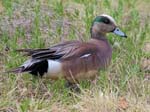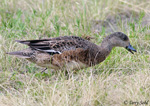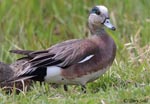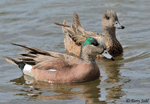| Length: 18 - 22 inches | Wingspan: 30 - 35 inches | Seasonality: Summer / Migrant |
| ID Keys: White forehead and crown, green eyestripe, blue-gray bill tipped in black. | ||
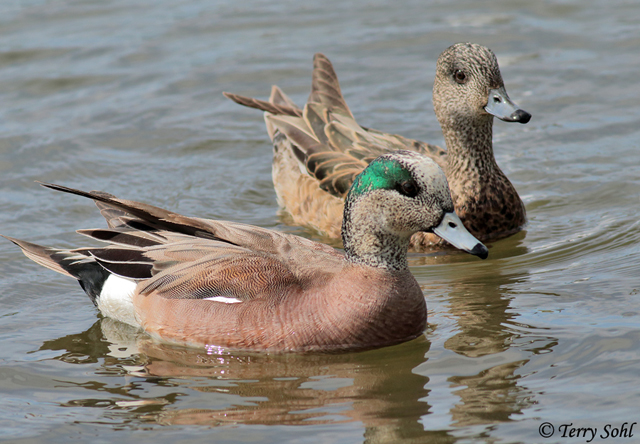 American
Wigeon are also known as the "Baldpate" by many hunters, because
of its white forehead and crown. The American Wigeon spends much of their
time foraging in and around aquatic environments, but they are also comfortable
foraging on land, eating young plant shoots and seeds. They are
also much more likely than most dabbling ducks to be found in deep water, where
they sometimes harass other duck species and steal their food.
American
Wigeon are also known as the "Baldpate" by many hunters, because
of its white forehead and crown. The American Wigeon spends much of their
time foraging in and around aquatic environments, but they are also comfortable
foraging on land, eating young plant shoots and seeds. They are
also much more likely than most dabbling ducks to be found in deep water, where
they sometimes harass other duck species and steal their food.
Habitat:
Prefers large inland marshes for breeding. Can be found in a variety of aquatic habitats during the winter and in migration, including ponds, lakes, rivers, fresh or saltwater marshes, and coastal estuaries.
Diet:
Primarily plant material, and is comfortable feeding both on aquatic and terrestrial vegetation. This includes plants such as duckweed, fresh stems of herbaceous grasses, underwater aquatic vegetation, and seeds and roots of many plants. American Wigeons will also eat insects, insect larvae, and snails, particularly during the nesting season. They have adapted well to a human presence and will feed on waste grain if available.
Behavior:
Uses a wide variety of foraging techniques, from tipping to submerge the head, picking food items from the water's surface, feeding on dry land, and stealing food from other waterfowl. They are more comfortable walking and feeding on land than some other waterfowl.
Nesting:
June and July in South Dakota. The nest site of an American Wigeon is on dry ground, often a surprisingly long distance from water or wetlands. It is located in a protected area on the ground, such as amongst tall vegetation. The nest is a small scrape on the ground, lined with grasses, other herbaceous vegetation, and down. The female lays between 4 and 12 eggs, and she alone incubates them. The eggs hatch after about 23 days. The young leave the nest soon after hatching and pursue food on their own, although the female will protect them.
Interactive eBird Map:
Click to access an interactive eBird map of American Wigeon sightings
Song:
A rather vocal species, American Wigeon males have a high, squeaky whistle that's vocalized in a number of situations, including in courtship and when disturbed. Females have a different quacking call.
1Click here to hear the quacking call of a female American Wigeon, recorded in Routt County, Colorado.
2Click here to hear the whistled vocalizations of a group of American Wigeon, recorded in King County, Washington.
3Click here to hear the calls of a male American Wigeon in flight, recorded in Quebec
Migration:
Summers throughout most of Canada, Alaska, and the northern third of the United States. Winters along the North American coasts, the southern third of the United States, and points south, including Mexico, the Caribbean, Central America, and northern South America.
Similar Species:
Male is generally distinctive, if seen well. The more plainly patterned females could potentially be confused with other dabbling ducks.
- Eurasian Wigeon - Even the most similar male duck is easy to distinguish from a male American Wigeon, and Eurasian Wigeons are just a rare visitor to North America. Eurasian Wigeons share the same "bald pate" on the forehead, but the head is primarily brown and lacks any green or colored stripe as seen on the American Wigeon. Female American and Eurasian Wigeons are more difficult to differentiate. Female Eurasian Wigeons tend to have warmer brown tones on their head and neck, as well as on their flanks.
- Green-winged Teal - The point of confusion between a male American Wigeon and male Green-winged Teal is that they both share a green stripe from the eye through the back of the head. However, Green-winged Teal are smaller, have a rich chestnut colored face and neck, have a more gray colored body, and have a white vertical stripe on their sides, below their neck. Female Green-winged Teals and American Wigeons might also be confused, but Green-winged Teals are smaller and have a longer more monotone bill.
- Gadwall - With a lack of the bald head or green eye stripe, male Gadwalls are unlikely to be confused with male American Wigeons, but they might be confused with females. However, male Gadwalls are darker overall, and have a darker, more uniform colored bill than a female American Wigeon.
Conservation Status:
Records over the last several decades (Christmas Bird Count, Breeding Bird Survey, etc.) show populations have been relatively stable. Their range has expanded eastward in recent decades. They are found across a very broad geographic area and are quite common in parts of their range. The IUCN considers the American Wigeon to be a species of "Least Concern".
Further Information:
1) USGS Patuxent Bird Identification InfoCenter, American Wigeon
3) Audubon Guide- American Wigeon
Photo Information:
May 15th, 2014 - Near Anchorage, Alaska -- Terry L. Sohl
Audio File Credits:
1Andrew Spencer, XC100899. Accessible at www.xeno-canto.org/100899
2Bruce Lagerquist, XC404504. Accessible at www.xeno-canto.org/404504
3Martin St-Michel, XC187408. Accessible at www.xeno-canto.org/187408
| Click on the map below for a higher-resolution view |
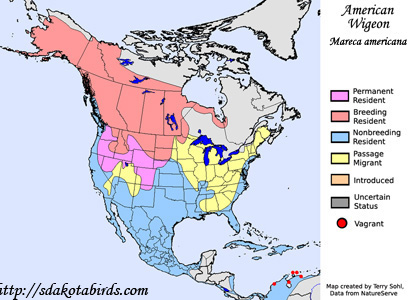 |
| South Dakota Status: Common migrant and uncommon Summer resident throughout the state. Rare to uncommon in winter. |
Additional American Wigeon Photos
Click for a higher-resolution version of these photos
